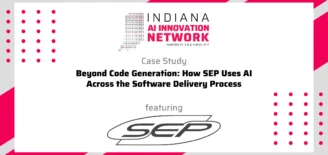Assuming your customers are happy is a bad idea.
What voices are the most important voices to be heard for any B2B business? My hope is that most people would agree that you have to hear the customer’s (or potential customer’s) input.
You simply will not have a business if you do not have a customer to sell your products or services to. However, customer feedback is rarely collected appropriately, and even if it is collected it is not distributed effectively to the entire company or to the people who need to see it most.
Indiana-based startup getSayDo is a software-as-a-service feedback engine that has made this process smoother and more effective. They have made vendor feedback easy to request and easy to distribute. They have found that some companies do not even know that they have a problem, and that the gap between companies that believe they deliver a superior customer experience and agreeing customers is shocking.
Help getSayDo win a feature contest!
getSayDo is competing for a featured spot on The Supplier Spotlight for small businesses. Click the button below and choose getSayDo to help them advance.
Voting ends TODAY, August 24th at 5 p.m.

“Our model is naturally viral,” said CEO Lawrence McGlown. “We enable an enterprise to score their vendors. Then, we incentivize the enterprise to share the results with their vendors.”
Here’s how it works: using getSayDo, you ask your customers for their feedback, it takes them less than a minute to respond, and then whomever you want to see the feedback can see it instantly. It is a very simple and straightforward process that leaves little room for feedback to slip through the cracks.
Customers provide feedback via a color coded dial — green is excellent, red is poor — for up to six different areas.
The feedback can then be separated by location, cause, and many other distinctions. You can analyze the feedback and develop plans to move forward shoring up your strongest areas and improving your weakest areas according to your vendors’ advice. Plus, you can trust that the responses are credible because getSayDo monitors the email addresses, businesses and conducts random feedback audits.
getSayDo is so easy to use and delivers clear instruction on areas of strength and needed improvement, that McGlown is banking on continued viral growth.
“I think we know that it can be difficult to get people to fill out surveys … this is commonly known information,” Lawrence said. “Once people see getSayDo used with one company and then it pops up with another company, they will start to become more and more comfortable with these new surveys and be more likely to fill them out. When they realize that the survey actually only takes a minute, compared to the normal ten to fifteen minutes, it could prompt them to respond more often.”
getSayDo could also help customers voices actually be heard more. If many people are seeing the feedback right away, rather than just the one person who gathers the information, it is less likely that the information will be swept under the rug. If everyone knows the feedback they will feel more inclined to do something to fix the problems that arise.
We asked founder Lawrence McGlown a few questions about getSayDo and his responses are below. Learn more about getSaydo by watching this short video about their vision.
What are the three most important features of getSayDo? What is your secret sauce?
getSayDo helps the procurement function diagnose, at any point in time, how employees “feel” about the vendors they rely on – making it easier to keep vendors calibrated to customers’ expectations.
What pain points are most prevalent for customers seeking your services in the marketplace today?
The Procurement function has a difficult time getting vendor performance feedback from their own employees. Turnkey solutions exist, but they’re costly and complex.
Can you outline the experience of developing getSayDo? What was the genesis?
Through years of consulting engagements, via The McGlown Group, we’ve discovered that many B2B companies (from mid-size to enterprise) lack fingertip access to customer feedback. When feedback exists, it’s costly, difficult to manage, and only accessible to specific departments or employees — forcing companies as a whole to make assumptions about customer expectations.
Tell us about the team who built getSayDo. What was most challenging?
Our team is comprised of SticksnLeaves, Connect Think, and Colton Voege, an intern from Purdue. Achieving simplicity in the face of a complex business problem was the most challenging barrier we overcame.
Albeit mind-boggling, a lot of vendors are okay with making assumptions about their customers. However, customer testing enabled us to identify market fit – the procurement function is not okay with status-quo. Thus, we interviewed 100+ procurement professionals and used their insight to guide a refresh of our value proposition and product strategy.
How would you describe your growth trajectory in the short-term and long-term?
When it comes to startups, the business community is enamored with the Hare from Aesop. Given our experience, we prefer the slow & steady approach of the Tortoise. Our short-term goal is to establish a customer community that will help co-create our vision. Once established, we will tackle break-out growth with precision, and do so profitably.
What are the biggest lessons you have learned through creating and launching getSayDo?
1) Swing away. Put your MVP (Minimum Viable Product) in the hands of paying customers. Listen, and they will tell you what’s required to achieve MLP (Minimum Lovable Proof). Your swing will improve, as evidenced by inbound calls and appointments.
2) Champion your vision. 1-minute innovators, people who have no intent to buy your product, are everywhere. They’re quick to tell you how it should be done, despite the fact they’ve never done what you’re doing. Shut them down, and focus on people interested in “WHY” you’re working to improve work life/personal life.
3) Keep choppin’ that wood! Most prospects don’t know they’re living with a problem. Don’t bite the “what’s getSayDo?” bait. Answer with questions that help prospects realize how work life/personal life can be better. By doing so, you avoid vomiting on prospects, and gain a deeper understanding of who wants your product.


